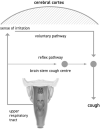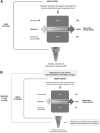Upper Respiratory Tract Infection-Associated Acute Cough and the Urge to Cough: New Insights for Clinical Practice
- PMID: 33406022
- PMCID: PMC7875114
- DOI: 10.1089/ped.2019.1135
Upper Respiratory Tract Infection-Associated Acute Cough and the Urge to Cough: New Insights for Clinical Practice
Abstract
Upper respiratory tract infection (URTI)-associated acute cough is the most common symptom both in children and adults worldwide and causes economic and social problems with significant implications for the patient, the patient's family, and the health care system. New pathogenic mechanisms in acute cough, including the urge to cough (UTC) mechanisms, have been recently identified. The brainstem neural network, pharyngeal sensory innervation, airway mechanical stimulation, inflammatory mediators, and postnasal drip actively participate in the onset and maintenance of acute cough and the urge to cough phenomenon. However, there is still no effective pharmacological treatment capable of interfering with the pathophysiologic mechanisms involved in URTI-associated acute cough. Moreover, severe adverse events frequently occur in administering such cough medications, mainly in children. New evidence has been provided concerning polysaccharides, resins, and honey as potential cough relievers with high antitussive efficiency, effect on the UTC, and minimal side effects.
Keywords: acute cough; children; honey; pathophysiology; polysaccharides; treatment; upper respiratory tract infection; urge-to-cough.
Conflict of interest statement
No competing financial interests exist.
Figures



References
-
- Shields MD, Bush A, Everard ML, et al. . Recommendations for the assessment and management of cough in children. Thorax 2008; 63(Suppl III):1–15 - PubMed
-
- Gibson PG, Simpson JL, Ryan NM, et al. . Mechanisms of cough. Curr Opin Allergy Clin Immunol 2014; 14:55–61 - PubMed
-
- Chang AB, Glomb WB. Guidelines for evaluating chronic cough in pediatrics: ACCP evidence-based clinical practice guidelines. Chest 2006; 129:260S–283S - PubMed
-
- Galway NC, Shields MD. The child with an incessantr dry cough. Paediatr Respir Rev 2019; 30:58–64 - PubMed
Publication types
MeSH terms
Substances
LinkOut - more resources
Full Text Sources
Medical

